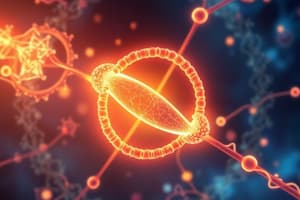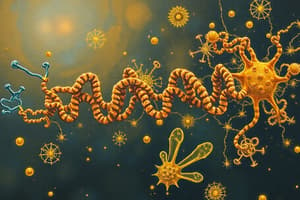Podcast
Questions and Answers
What is the primary source of free energy for phototrophs?
What is the primary source of free energy for phototrophs?
- Light energy from the sun (correct)
- Chemical oxidation of nutrients
- Mechanical work done on cells
- Conversion of carbohydrates
Which process is directly coupled to endergonic reactions in living systems?
Which process is directly coupled to endergonic reactions in living systems?
- Nutrient breakdown
- Photosynthesis
- Oxidation of inorganic compounds
- Synthesis of high-energy phosphate compounds (correct)
What is a key characteristic of living organisms in relation to their metabolic processes?
What is a key characteristic of living organisms in relation to their metabolic processes?
- They operate at equilibrium
- They only perform exergonic reactions
- They require no influx of energy
- They maintain a steady state despite consuming nutrients (correct)
What is the main purpose of metabolic regulatory systems in living organisms?
What is the main purpose of metabolic regulatory systems in living organisms?
How do chemotrophs primarily acquire free energy?
How do chemotrophs primarily acquire free energy?
What is particularly notable about the metabolic reactions in living organisms despite their complexity?
What is particularly notable about the metabolic reactions in living organisms despite their complexity?
Which of the following statements about the steady state in humans is accurate?
Which of the following statements about the steady state in humans is accurate?
What role do oxidation-reduction reactions play in metabolism?
What role do oxidation-reduction reactions play in metabolism?
What is the primary role of catabolism in metabolic pathways?
What is the primary role of catabolism in metabolic pathways?
Which of the following statements about ATP and NADPH is correct?
Which of the following statements about ATP and NADPH is correct?
What common intermediate is produced from the degradation of carbohydrates, lipids, and proteins?
What common intermediate is produced from the degradation of carbohydrates, lipids, and proteins?
Which type of metabolic reaction is responsible for synthesizing biomolecules?
Which type of metabolic reaction is responsible for synthesizing biomolecules?
Why must metabolic pathways involve various distinct enzymes?
Why must metabolic pathways involve various distinct enzymes?
What characterizes the relationship between different metabolic pathways in a cell?
What characterizes the relationship between different metabolic pathways in a cell?
What occurs during the catabolic breakdown of foodstuffs?
What occurs during the catabolic breakdown of foodstuffs?
What is the result of the coupling of catabolic and anabolic pathways?
What is the result of the coupling of catabolic and anabolic pathways?
What is a characteristic of the first committed step in a metabolic pathway?
What is a characteristic of the first committed step in a metabolic pathway?
Which of the following best describes the nature of metabolic pathways?
Which of the following best describes the nature of metabolic pathways?
Why must catabolic and anabolic pathways differ?
Why must catabolic and anabolic pathways differ?
What does the irreversibility of metabolic pathways imply about their reactions?
What does the irreversibility of metabolic pathways imply about their reactions?
What role does regulation play in metabolic pathways?
What role does regulation play in metabolic pathways?
Which of the following metabolites primarily serves as starting materials for biosynthetic processes?
Which of the following metabolites primarily serves as starting materials for biosynthetic processes?
What feature of metabolic pathways allows them to maintain flexibility in response to cellular needs?
What feature of metabolic pathways allows them to maintain flexibility in response to cellular needs?
How does the pathway's directionality emerge according to the metabolic characteristics?
How does the pathway's directionality emerge according to the metabolic characteristics?
What is the primary reason for regulating the first committed step in a metabolic pathway?
What is the primary reason for regulating the first committed step in a metabolic pathway?
Which statement accurately describes the role of ATP in eukaryotic cells?
Which statement accurately describes the role of ATP in eukaryotic cells?
What is a key characteristic of the first committed step in a metabolic pathway?
What is a key characteristic of the first committed step in a metabolic pathway?
Why is compartmentation in eukaryotic cells important for metabolism?
Why is compartmentation in eukaryotic cells important for metabolism?
What limits the transport of acetyl-CoA across the mitochondrial membrane?
What limits the transport of acetyl-CoA across the mitochondrial membrane?
How does the regulation of metabolic pathways contribute to cell efficiency?
How does the regulation of metabolic pathways contribute to cell efficiency?
Which feature of biological membranes aids in selective permeability?
Which feature of biological membranes aids in selective permeability?
What is a consequence of the rate-limiting step being irreversible?
What is a consequence of the rate-limiting step being irreversible?
Flashcards are hidden until you start studying
Study Notes
Introduction to Metabolism
- Living organisms are not at equilibrium.
- They require a continuous input of free energy to maintain internal order.
- Metabolism is the process by which living systems acquire and utilize free energy.
- This process involves coupling exergonic reactions of nutrient oxidation to endergonic reactions to maintain life functions.
Acquisition of Free Energy
- Phototrophs (plants and certain bacteria) acquire free energy from the sun through photosynthesis.
- Photosynthesis transforms light energy into chemical energy stored in carbohydrates.
- Chemotrophs obtain free energy by oxidizing organic compounds derived from phototrophs.
Energy Coupling
- Free energy is often coupled to endergonic reactions through the synthesis of "high-energy" phosphate compounds like ATP.
- ATP is a key molecule for energy transfer in cells.
Metabolic Pathways: Overview
- Metabolic pathways are series of consecutive enzymatic reactions producing specific products.
- Metabolites are the reactants, intermediates, and products of these pathways.
Types of Metabolic Pathways
- Catabolism (degradation): Breakdown of nutrients and cell constituents to release components and generate free energy.
- Anabolism (biosynthesis): Synthesis of biomolecules from simpler components using energy from catabolic reactions.
Central Intermediates
- Catabolic pathways convert diverse substances (carbohydrates, lipids, and proteins) into common intermediates.
- These intermediates are then further metabolized in central oxidative pathways.
- Acetyl-CoA is a vital intermediate in catabolic pathways.
Key Characteristics of Metabolic Pathways
- Irreversible: Metabolic pathways have a direction due to highly exergonic reactions.
- Distinct Catabolic and Anabolic Pathways: The reverse process of converting a metabolite back to its precursor requires separate pathways due to the need for energy input.
- First Committed Step: Each pathway has an irreversible reaction that commits intermediates to continue the pathway.
- Regulation: Metabolic pathways are regulated by supply and demand mechanisms.
- Compartmentalization: Metabolic pathways occur in specific cellular locations in eukaryotic cells, allowing for more efficient control and regulation.
ATP and NADPH
- ATP and NADPH are the major free energy sources for anabolic pathways.
- ATP is generated from ADP and phosphate during catabolism.
- NADPH is reduced from NADP+ during catabolic pathways.
Compartmentalization
- Different metabolic pathways often occur in specific cellular compartments.
- The mitochondrion is the site of ATP production.
- Different metabolic pathways are regulated or controlled in different locations.
Examples of Compartmentalization
- Synthesis of ATP mainly occurs in the mitochondria but is used in the cytoplasm.
- Acetyl-CoA is used for fatty acid synthesis in the cytoplasm but is made in the mitochondria.
Studying That Suits You
Use AI to generate personalized quizzes and flashcards to suit your learning preferences.




